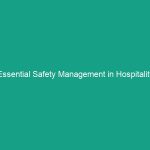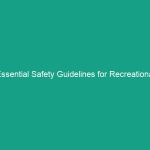Introduction
Good morning team! Today, we’re diving into a crucial topic that impacts all of us at work: Essential HSE Guidelines: Avoid These Critical Risks in Your Workplace. Understanding and adhering to these guidelines is vital for maintaining a safe working Environment. Safety is not just a policy; it’s a culture that protects our health and wellbeing.
In this Toolbox Talk, we’ll explore common risks and how to avoid them, ensuring that everyone leaves with practical advice they can apply immediately. Remember, safety is everyone’s responsibility, and being informed is the first step toward a safer workplace.
Understanding Essential HSE Guidelines
Essential HSE guidelines encompass various practices and Standards aimed at ensuring health, safety, and environmental protection in the workplace. These guidelines are not merely suggestions; they are essential components that protect us from potential Hazards that can lead to injury, illness, or worse.
Many employees might think that accidents won’t happen to them or that Safety protocols are overly cautious. However, the reality is that most workplace incidents can be prevented by simply following established Safety Guidelines. Understanding these guidelines and their importance can significantly impact our daily operations and overall Safety culture.
Key Hazards, Risks, and Safety Considerations
Understanding the key hazards associated with your work environment is the foundation of Workplace Safety. Here are some critical risks to be aware of:
- Slips, Trips, and Falls: One of the most common workplace injuries, often caused by wet floors, uneven surfaces, or cluttered walkways.
- Hazardous Materials: Exposure to chemicals or other harmful substances can lead to serious health issues if proper Safety Measures are not followed.
- Machinery and Equipment: Improper use or lack of Maintenance can result in accidents or malfunctions.
- Fire Hazards: Inadequate fire Safety Measures can lead to catastrophic outcomes.
Ignoring these risks can lead to severe consequences, including injuries, legal ramifications, and increased insurance costs. It’s crucial to recognize that safety measures are in place to protect you and your colleagues.
Best Practices, Procedures, & Actionable Advice
Here are some actionable steps to mitigate these risks and enhance Workplace Safety:
1. Slips, Trips, and Falls
- Keep walking surfaces clean and free of obstacles.
- Use anti-slip mats in areas prone to moisture.
- Report any spills immediately and ensure they are cleaned up properly.
2. Handling Hazardous Materials
- Always wear appropriate Personal Protective Equipment (PPE) when handling chemicals.
- Follow Material Safety Data Sheets (MSDS) for information on hazards and safety Precautions.
- Ensure proper storage of hazardous substances to prevent leaks or spills.
3. Machinery and Equipment Safety
- Receive Training before operating any machinery.
- Conduct regular maintenance checks on equipment to ensure they are in safe working order.
- Always use the proper safety guards and devices during Operation.
4. Fire Safety Protocols
- Familiarize yourself with the location of fire exits and extinguishers.
- Participate in regular fire drills to ensure everyone knows the Evacuation Procedures.
- Keep flammable materials away from heat sources.
Real-life incidents highlight the significance of these practices. For instance, a recent case involved a worker slipping on a wet floor, resulting in a serious injury. This incident could have been avoided with proper signage and immediate cleanup.
Regulations, Standards, and Compliance
Compliance with safety Regulations is not just a legal obligation; it’s a moral one. Organizations like OSHA (Occupational Safety and Health Administration) set forth guidelines that protect workers from workplace hazards. Understanding and adhering to these regulations is critical for maintaining a safe work environment.
Failure to comply can result in serious consequences, including fines, legal actions, and, most importantly, injury to employees. It’s essential to stay updated on both federal and local regulations, as well as company-specific safety policies.
Employee Engagement & Discussion
Now that we’ve covered the essential guidelines and Best Practices, let’s engage in a discussion. I want to hear from you:
- What safety challenges have you encountered related to these guidelines?
- Do you feel you have the necessary resources to follow safety protocols effectively?
- How can we improve our safety culture as a team?
Your thoughts and experiences are invaluable in creating a safer workplace. Let’s share and learn from each other!
Conclusion & Key Takeaways
In conclusion, adhering to essential HSE guidelines is pivotal in avoiding critical risks in our workplace. Remember the key points we discussed:
- Identify and understand workplace hazards.
- Follow Best Practices and Procedures to mitigate risks.
- Stay compliant with safety regulations to protect yourself and your colleagues.
By prioritizing safety, we not only protect ourselves but also contribute to a positive safety culture within our organization. Thank you for your attention and commitment to safety. Let’s continue to work together to make our workplace a safe environment for everyone.


